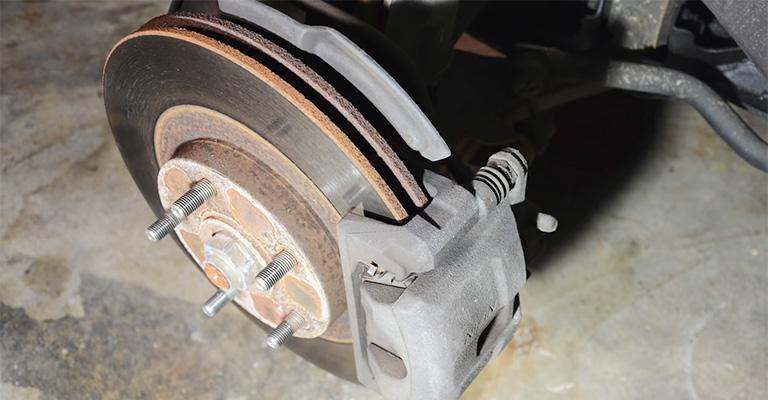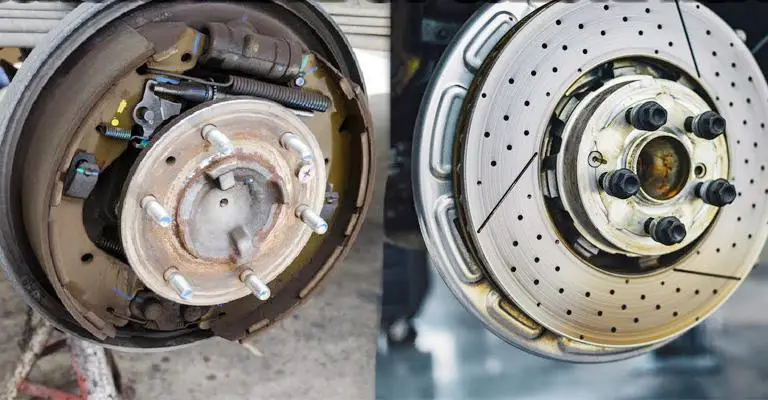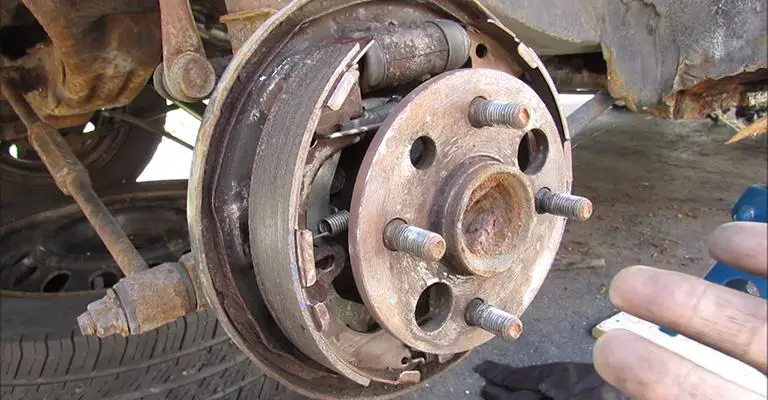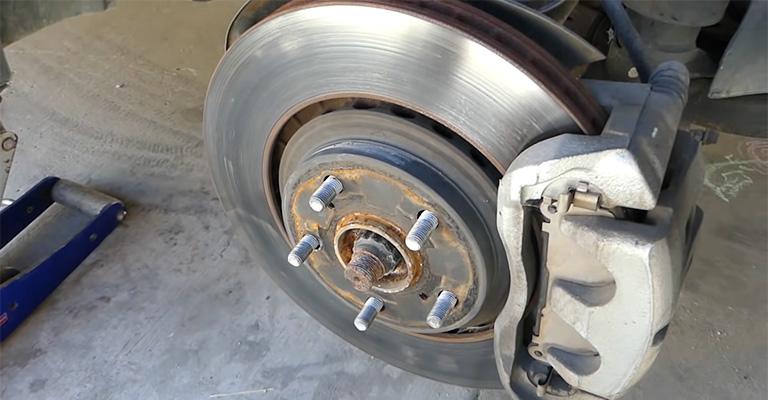Are you curious about what kind of brakes your car has? Knowing what type of brakes your vehicle has is important for understanding how they work and properly maintaining them.
This blog post will explain how to determine what kind of brakes your car has and provide tips for keeping them in good condition.
Whether you’re a car enthusiast or just want to ensure your vehicle is safe and reliable, this information will be useful. So, let’s get started!
There are several ways to determine what kind of brakes a car has:

Contents
- 0.1 Check The Owner’s Manual
- 0.2 Visually Inspect The Brakes
- 0.3 Ask The Dealership Or Previous Owner
- 0.4 Consult A Mechanic
- 1 What Kind Of Brakes Do I Have On My Car?
- 2 Final Words
Check The Owner’s Manual
The owner’s manual will usually specify what type of brakes the car has.
Visually Inspect The Brakes
You can try to identify the type of brakes by looking at them. Some common types of brakes include disc brakes, drum brakes, and hydraulic brakes.
Disc brakes have a disc-shaped rotor attached to the wheel and a caliper that presses a pad against the rotor to create friction.
Drum brakes have a drum-shaped housing that surrounds the brake shoes and a wheel cylinder that pushes the shoes outward to create friction.
Hydraulic brakes use a fluid-filled system to transfer force from the brake pedal to the brakes themselves.
Ask The Dealership Or Previous Owner
If you are unsure what type of brakes a car has, you can try asking the dealership or previous owner for more information.
Consult A Mechanic

If you are still unsure what type of brakes a car has, you can take it to a mechanic and have them inspect the brakes for you. They will be able to tell you what type of brakes the car has and provide any necessary maintenance or repairs.
What Kind Of Brakes Do I Have On My Car?
Nowadays, disc brakes are commonly installed on the front of new vehicles, while drum brakes are fitted on the back.
A disc brake is not uncommon to find on all four wheels. Some older vehicles are still equipped with drum brakes all around – disc brakes were introduced in the 1970s.
It is just as true that brake technology has evolved over the last few years as suspension technology and fuel-system technology have.
As early as the 1970s, manufacturers began switching from drums to disc brakes on a wide scale to improve braking.
A guide to disc brakes and drum brakes with information on what they are, how they work, and which one is better can be found here.
How To Tell Whether Your Brakes Are Drum Or Disc?

To double-check, look through one of the holes in the top of the front wheel. If you see a shiny surface, your disc rotor will have a smooth metal surface.
On the other hand, if you see a rusty and not smooth round surface, that’s where your brake drum is. Some rotors will likely have rust specklings.
Another way to check is to look at the back of the wheel – disk brakes use rubber hoses to connect to the calipers, while drum brakes use metal tubes.
Your car’s brakes can be assessed without jacking up or removing the wheels. Here are some steps you can follow to determine what type of brakes your car has.
Step 1
You can see the front wheel through one of the holes at the top. The front brake rotor, a polished smooth surface behind the wheel, is visible if your vehicle has disc brakes. The brake drums will look rusted if the car does not have disc brakes up front.
Step 2
Look at the inside through one of the holes on the top of one of the rear wheels. There will be one of two types of brake rotors: smooth, shiny, and flat, or round, rough, and almost certainly rusted.
Step 3
If you cannot see clearly through a hole in the wheel, you can inspect the back side of the wheel and tire. It is common for disc brakes to have rubber hoses connected to their brake calipers; drum brakes will have metal tubes.
Step 4
There are several ways to determine whether or not your car has anti-lock brakes:
- Watch the warning lights on the instrument panel when the ignition is turned on. Detecting an ABS or anti-lock brake system will illuminate an “ABS” or “Anti-lock” light.
- You can find wires behind each wheel. It is important to check both front and rear ABS, as some vehicles only have front ABS, and others may have both.
- Give your VIN to your dealer and ask.
Step 5
On the rear of the driver’s side of the engine compartment, look for a large, round metal can about 10 or 12 inches in diameter. The power brake booster looks like this. A power brake system is installed in your car if you have one of these.
About Drum Brakes

A drum brake was installed at each wheel of the first cars produced by automotive manufacturers. Their name comes from the fact that all the brake components are contained within a round drum.
Braking slows down the wheel by putting pressure on the shoes inside the drum. Since the drums cannot contain the heat buildup caused by steep hills or aggressive braking, these brakes often fade.
Consequently, drum brakes were considered unsafe for these conditions due to their design flaw and performance failures.
How Often Do Car Drum Brakes Need Replacing?
There is a warranty of approximately 200,000 miles on the drums themselves. Despite this, all vehicles are different. Schedule routine brake inspections at your nearest car center to ensure your brakes don’t wear out.
About Disc Brakes

Disc brakes were discovered to perform better on the track back then when manufacturers discovered that car racers enjoyed better performance.
Instead of using brake shoes in the brake drum, the disc (or rotor) is exposed to outside air, and braking is accomplished with the caliper and brake pads.
As opposed to a drum brake, which traps the heat, the disc brake allows the brake actually to cool down. The heat was allowed to escape from the braking system with this new at-the-time design, allowing for a dramatic improvement in braking performance.
As most cars became front-wheel-drive and braking power (60-90% of it) came from the front wheels, disc brakes were adopted as the front wheels receive the majority of braking power.
It’s perfectly safe for most new vehicles to have a front disc and rear drum brake setup because they have improved since the 1970s.
How often do rotors need service?
There is a range of mileage between 15,000 and 70,000 miles between brake rotors needing to be replaced. To replace a rotor, however, you must first check if the rotor has been damaged and if it can be resurfaced to meet the manufacturer’s thickness standard.
Types Of Brakes On Your Car
Your vehicle may have disc brakes or drum brakes for stopping or slowing down, but there are more brakes than these!
In addition, there is an emergency brake, also referred to as a parking brake, which bypasses the normal braking system. In case of malfunctioning brakes, these use levers or cables to stop the automobile.
In most cases, these stop the car from the rear. You may also have Anti-lock Braking Systems (ABS) on a newer vehicle model.
What Is The Difference Between Disc Brakes And Drum Brakes?
For several reasons, disc brakes are generally considered superior to drum brakes. As a result, they dissipate heat better (braking works by converting motion energy into thermal energy).
The effectiveness of disc brakes diminishes longer as they are used more frequently, such as during repeated stops or when riding down an incline.
Wet weather is also better for disc brakes, as centrifugal force repels water from the disc surface and keeps it dry, whereas drum brakes collect water on the braking shoes where they contact the drum surface.
Why Do So Many Cars Still Use Rear Drum Brakes?
Disc brakes are on all vehicles sold in the United States, but drum brakes are still used on many cars in the rear. The car’s weight moves forward when you brake, so the front brakes perform 70% of the work.
The reason why your front brakes wear out faster is that they are exposed to more heat. Manufacturers can provide the most benefits of disc brakes while lowering costs by using disc brakes on the front wheels and drum brakes on the rear wheels.
There is a significant cost difference between drum brakes and disc brakes because drum brakes can also be used as parking brakes, whereas disc brakes require a separate mechanism for parking.
However, a four-wheel disc brake car (compared to a front disc/rear drum car) will still offer better braking in wet weather. Nevertheless, long downgrades are always better accomplished with downshifts and the engine controlling speed.
Final Words
Disc brakes are common on cars built in the last thirty years, while drum brakes may be used at the rear. Possibly, some or all of the brake assembly can be seen if the car has wheels with large openings.
The brakes on every car have two in the front and two in the back. Drum brakes are typically found on the front and rear of old vehicles.
A modern car has four wheels equipped with disc brakes for all four wheels, four wheels equipped with disc brakes for the front, and four wheels equipped with drum brakes for the rear.
By applying brake pressure to the pedal, both types of brakes create friction, causing a vehicle to stop, either hydraulically or with a brake pad or brake shoe.
